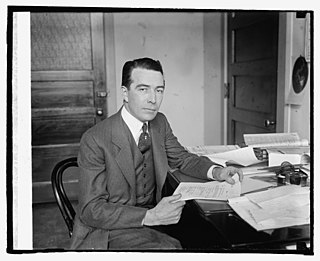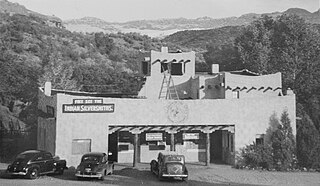
Bakelite, formally polyoxybenzylmethyleneglycolanhydride, is a thermosetting phenol formaldehyde resin, formed from a condensation reaction of phenol with formaldehyde. The first plastic made from synthetic components, it was developed by Leo Baekeland in Yonkers, New York, in 1907, and patented on December 7, 1909.

Costume or fashion jewelry includes a range of decorative items worn for personal adornment that are manufactured as less expensive ornamentation to complement a particular fashionable outfit or garment as opposed to "real" (fine) jewelry, which is more costly and which may be regarded primarily as collectibles, keepsakes, or investments. From the outset, costume jewelry — also known as fashion jewelry — paralleled the styles of its more precious fine counterparts.

Lisa Coles Guerrero is an American journalist, actress, former sportscaster, artist, and model. Since 2006, Guerrero has been an investigative correspondent for the nationally syndicated newsmagazine Inside Edition.

Harry Bertoia was an Italian-born American artist, sound art sculptor, and modern furniture designer.

Fire-King is an Anchor Hocking brand of glassware similar to Pyrex. It was formerly made of low expansion borosilicate glass and ideal for oven use. Currently it is made of tempered soda-lime-silicate glass in the US and borosilicate in Japan

Oberführer was an early paramilitary rank of the Nazi Party (NSDAP) dating back to 1921. An Oberführer was typically an NSDAP member in charge of a group of paramilitary units in a particular geographical region. From 1921 to 1925, the phrase Oberführer was used as a title in the Sturmabteilung (SA), but became an actual SA rank after 1926.

Guess Inc. is an American clothing company, notable for its black-and-white advertisements. Guess licenses its brand on other fashion accessories, such as watches, jewelry, perfumes, bags and shoes.

Carnival glass is moulded or pressed glass to which an iridescent surface shimmer has been applied. It has previously been referred to as aurora glass, dope glass, rainbow glass, taffeta glass, and disparagingly as 'poor man's Tiffany'. The name Carnival glass was adopted by collectors in the 1950s as items of it were sometimes given as prizes at carnivals, fetes, and fairgrounds. However, evidence suggests that the vast majority of it was purchased by households to brighten homes at a time when only the well-off could afford bright electric lighting, as its finish catches the light even in dark corners. From the beginning of the 20th century, carnival glass was mass-produced around the world, but largely and initially in the U.S. It reached the height of its popularity in the 1920s, though it is still produced in small quantities today.

Eugene F. McDonald (1886–1958) founded Zenith Radio in 1921, a major American radio and electronics manufacturer for most of the twentieth century.

Herschel Harper "Herky" Green was a World War II flying ace in the United States Army Air Forces. Green was the leading ace of the Fifteenth Air Force, shooting down 18 enemy aircraft and destroying 10 more on the ground.
Marcel Boucher (1898–1965) was a French jeweller. In the early 1920s, he moved to New York City, where he developed a passion for jewellery design, By the 1930s, he was working for Mazer Brothers. However, in 1937 he decided to establish his own company, which he called Marcel Boucher and Cie.

Michael Kabotie, also known as Lomawywesa was a Hopi silversmith, painter, sculptor, and poet. He is known for his petroglyph and geometric imagery.
James A. "Jim" Gibbs was a United States author, lighthouse keeper, and maritime historian.

Bing & Grøndahl was a Danish porcelain manufacturer founded in 1853 by the sculptor Frederik Vilhelm Grøndahl and merchant brothers Meyer Hermann Bing and Jacob Herman Bing. The trademark backstamp for Bing & Grøndahl (B&G) porcelains is the three towers derived from the Coat of Arms of Copenhagen. The company's Seagull dinnerware series became known as the "National Service of Denmark" in the 1950s when it was found in one tenth of all Danish households. In 1987 the company merged with its primary competitor, the Royal Porcelain Factory under the name Royal Copenhagen.

Marshmallow Love Seat #5670, commonly known as the Marshmallow sofa, is a modernist sofa produced by the American furniture company Herman Miller, that was initially manufactured between 1956 and 1961. It is considered the most iconic of all modernist sofas. The sofa was designed by Irving Harper of George Nelson Associates. It was produced in two lengths from 1956 to 1961. It consists of a metal frame with round discs of covered foam, or "marshmallows", spread across the seat and back in a lattice arrangement.

California pottery includes industrial, commercial, and decorative pottery produced in the Northern California and Southern California regions of the U.S. state of California. Production includes brick, sewer pipe, architectural terra cotta, tile, garden ware, tableware, kitchenware, art ware, figurines, giftware, and ceramics for industrial use. Ceramics include terra cotta, earthenware, porcelain, and stoneware products.
Richard Rohac (1906–1956) was an Austrian designer and master metal craftsman.

The Garden of the Gods Trading Post is a historic site in Manitou Springs, Colorado. It is adjacent to the Colorado Springs public park Garden of the Gods.
Time Warp is a 4-player Solid State Electronic pinball machine from September 1979 produced by Williams. A total of 8,875 units were produced.
















